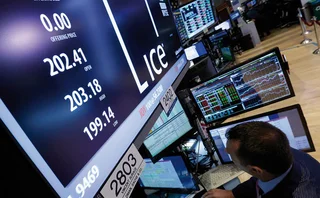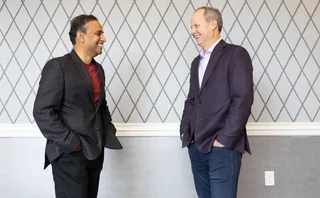NYSE President Sees Tech as Key to Big Board's Next Evolution
A look at the massive tech projects (and legal battles) underway at the NYSE, which are being led by Stacey Cunningham.
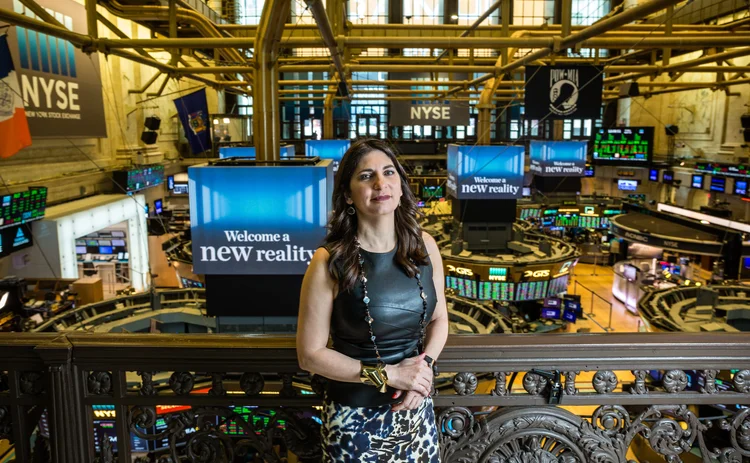
After 226 years of existence, Stacey Cunningham became the first woman to head the New York Stock Exchange (NYSE) in 2018. You probably already know this. Moreover, the venerable NYSE is now owned by the Intercontinental Exchange, founded in 2000—or nearly 76,000 days after the Buttonwood Agreement. Even if you didn’t know the number of days, you should know that the ICE now owns the Big Board.
However, this is 2019 and Cunningham’s thoughts are not focused on these things that are now in the rear-view mirror. Instead, she leads an exchange in transition. For a decade, the famed trading floor has become decidedly less human and more electronic. It’s also one that has been under attack of late. Celebrated author Michael Lewis exalted the virtues of a startup exchange called the Investors Exchange (IEX) while denigrating the at-times-maligned Wall Street institution—as well as others perceived to be in the old boys club—in the book “Flash Boys.”
At the same time, there’s an all-fronts attack on exchange fees across the industry, with the likes of NYSE, Nasdaq, and Cboe Global Markets finding themselves to be unlikely allies. This battle helped to spawn the Members Exchange (MEMX), a proposed competitor to traditional equities exchanges. If it gets approved, it will be the 14th (or 15th, depending on timelines) stock exchange in the US. Additionally, major tech companies are waiting longer to go public and the fight to list companies is getting increasingly competitive in a fragmented market. There are also flash crashes to contend with, increasing volatility and a raft of new regulations.
As if all that wasn’t enough, cloud technology has completely changed the way that companies store, send and use data; computational power is improving exponentially; advancements in artificial intelligence (AI) are helping to revolutionize the way that humans interact with data and technology; and blockchain is…well…it’s there, in the ether. Oh, and the exchange, itself, is transitioning to a brand new trading platform, Pillar.
Change is, indeed, constant—perhaps especially for centuries-old institutions.
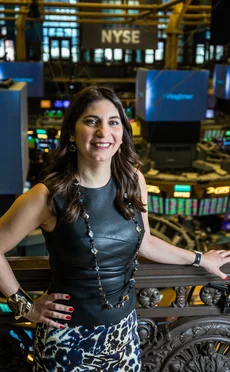
Homecoming
For Cunningham’s part, she was hooked by the NYSE from day one, as an intern back in the mid-90s. Her dad, a stockbroker at the Canadian trading house Nesbitt Burns, was able to help her get the gig, even though at the time, she was a civil engineer at Lehigh University in Bethlehem, Penn., and wasn’t looking for a summer corporate internship. Instead, she wanted to be a waitress, but since she had no experience waitressing, the fallback was the most iconic financial institution in the world, working with broker Murphey, Marseilles, Smith & Nammack. “I, frankly, think I would’ve been a fantastic waitress, but I didn’t have the opportunity,” she says with a laugh, but serious, too.
It’s that confidence—that ego—that helped her to not just survive on the testosterone-fueled trading floor of the 1990s, but to enjoy the experience enough to change her major to industrial engineering—a more general discipline—and she came back after she graduated from Lehigh.
“I fell in love with the trading floor almost instantly,” she says. “I was so fascinated by the markets, the pace and the energy that I wanted to go work there full-time. …It was almost like you were problem-solving because you were trying to get what seemed like an unreasonable amount of work done in a finite period—it was, how fast can you keep up? I just loved that nature of it. I loved the culture and the fact that it wasn’t about politics—you didn’t have time on the trading floor to worry about whose fault something was or what was the appropriate, or the best way to phrase something. You just had to be a clear communicator and get right to the point. I found that very liberating.”
In 2005, she left the exchange to pursue another passion of hers—cooking—and joined a culinary training course. She departed the NYSE in part because she felt that tech and humans weren’t integrating at the exchange.
“When I left, it felt as if we were using sophisticated technology and we had the benefit of people on the floor, but they weren’t integrated, they were side-by-side—almost in conflict. The evolution of technology was so fast that we really needed to rethink the way it was integrated. As a trader on the floor, it was almost as if I was fighting technology.”
Her time as a chef was brief, and she was soon at rival exchange operator Nasdaq, where she served a five-year stint, first as director of capital markets, before rising to head sales of transaction services in the US. The siren song of the Big Board continued to call, though, and she rejoined the exchange in 2012. She was named COO in 2015.
“I came back home. I grew up on the trading floor. I love the NYSE. I left at a crossroads in time where it was unclear how technology was going to be integrated—and it was clear to me that technology needed to be integrated more effectively. When I came back a few years later, it was clear to me that the NYSE was on a path toward the future and really making sure that we were able to scale our business like never before. That was exciting and being able to be part of a team whose job it was to reinvent a global icon, is not an opportunity you want to pass up.”
Cunningham was excited to embrace yet another change, but she didn’t know just how significant that change would be. She agreed to leave Nasdaq to rejoin the NYSE in 2012—10 days before ICE purchased the iconic institution.
Around the acquisition, there were a lot of moving parts. So the first thing that we did is we looked at the technology at the NYSE and concluded that it was not world class.
Jeff Sprecher
“It was shocking,” Cunningham, today, recalls. “I have been fortunate that I understand the value of change and that with change often comes great opportunity and new challenges.”
‘Not World Class’
Telling the story of how Cunningham is driving the next phase of the NYSE’s evolution requires an understanding of its parent company, ICE.
Some CEOs in the capital markets talk about big-T “Technology” but can’t get into the nitty gritty as to how the plumbing works. Jeffrey Sprecher is certainly not that. He received a degree in chemical engineering from the University of Wisconsin-Madison in 1978 before getting his MBA from Pepperdine University in 1984. Today, Sprecher is the chairman and CEO of ICE and is the Atlanta-based exchange group’s founder. He was also hands-on in designing the first version of ICE’s trading platform.
When ICE acquired the NYSE, it was called NYSE Euronext and had grown through several high-profile acquisitions. Sprecher says that the first thing was to run an assessment of the company’s business lines and tech platforms. The results weren’t encouraging—the organization was too massive, and the technology was not up to scratch.
“Around the acquisition, there were a lot of moving parts,” he recalls. “So the first thing that we did is we looked at the technology at the NYSE and concluded that it was not world class.” Additionally, NYSE Euronext had about 5,000 full-time employees and another 1,000 permanent contractors globally, and the Euronext piece did not fit into ICE’s plans for the NYSE. “There was just too much in the company for our management team to focus on at one time; we didn’t feel like we could focus on the unique challenges in Europe, so we spun that out.”
After divesting Euronext, ICE took the technology businesses that were part of NYSE Euronext, restructuring or merging some, and selling others. That left the Universal Trading Platform, which was anything but universal. The UTP was a hodgepodge of five different trading platforms—there were, at the time, three equity markets (the NYSE platform, the old American Exchange platform and the legacy Arca platform) and the two options markets (the Arca Options platform and the AmEx Options platform). That meant that behind the UTP’s API were five different systems that were running in parallel.
“We benchmarked those five platforms to see if there was one of them that we could standardize the entire business around and we came to the conclusion that they were all legacy platforms, that they were expensive to operate, they wouldn’t scale, they would ultimately become uncompetitive in a highly competitive market,” Sprecher says. “We decided to build a brand new platform from scratch, and that is known as the Pillar platform.”
Sprecher and the ICE team worked with Thomas Farley, who was the president of NYSE Group at the time of the acquisition, and the NYSE team, to get feedback on what the industry would want to see from a new trading platform on the exchange and to reposition the hoary institution for the tech-driven future. While this was unfolding, NYSE Group thinned its workforce from 6,000 in 2012 to a little over 940 employees, Sprecher says.
Stacey had the right background, and we thought she was the right person to come in and really deal with the fine-tuning of a repositioned company.
Jeff Sprecher
Another significant adjustment at the exchange is in its surveillance and compliance department, through the use of bots, natural-language processing, and machine learning. Sprecher notes that it was imperative to fix the NYSE’s ability to handle surveillance matters.
“When we inherited the NYSE there was a massive backlog of compliance investigations going on in the marketplace,” Sprecher says. “By deploying more technology around this, we can eliminate false-positives and get the compliance team focused on the obvious issues. Because the data is available immediately to the team, they can take action quickly.”
So, for example, when the NYSE took regulation in-house, the Financial Industry Regulatory Authority (Finra) had a backlog of several hundred single-market surveillance matters, more than half of which were over a year old, and about a quarter of which were two years old. Today, the average timeframe for a matter handled by NYSE Regulation is about 30 days.
It has also been able to improve its ability to test internal systems to make sure they comply. Under the new Regulation Systems Compliance and Integrity (Reg SCI) regime, exchanges must have their systems comply with their own rules. By deploying AI, they can more effectively test updates in advance to make sure there aren’t bugs in the system, and specific order interactions are in compliance, before going into full production, Cunningham says. Reg SCI isn’t a paper tiger, either—in March 2018, NYSE was fined $14 million by the SEC in connection with a four-hour market outage in 2015.
Back in the present, she is now a year into the job as president of the NYSE, at a period of unprecedented change for the exchange and the industry. Like Sprecher, she has a degree in engineering, though hers is in industrial and not chemical disciplines. (Showing the engineering and tech heft at the C-level, Mark Wassersug, ICE’s COO, Charles Vice, ICE’s vice chairman, and Stuart Williams, president of ICE Futures Europe, also have engineering degrees; Mayur Kapani, ICE’s CTO, holds a bachelors of technology degree from the Indian Institute of Technology Kharagpur, and Lynn Martin, president and COO of ICE Data Services, has a computer science degree from Manhattan College and a masters in statistics from Columbia University.)
With Cunningham, Sprecher says that he and the board found someone who could bridge the gap between the trading floor, the technologists and the business executives.
“Stacey had the right background, and we thought she was the right person to come in and really deal with the fine-tuning of a repositioned company,” Sprecher says. “She has a deep background in equity markets. As we’re finalizing Pillar, the NYSE has a unique model, which is a combination of technology and people. Getting the Pillar platform to optimize around that is really important to us, and Stacey is perfectly positioned to bring those last nuances that we need to that technology that we really think will differentiate our company.”
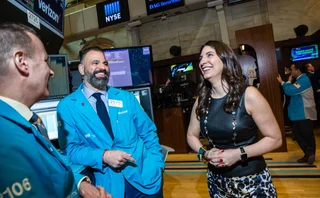
Hello, My Name is Human
The opening and closing bells of Nasdaq and the NYSE—Cunningham’s two homes—are vastly different. Nasdaq holds its ceremonies in a quiet studio, and a few dozen people are brought in off the street to help bring up the energy in the room by clapping and cheering. The trading floor of Nasdaq, like many others around the world, is one of machines, monitored by humans.
The NYSE, on the other hand, still has human traders on the floor. Some would argue that the floor traders serve more like props for the television cameras, and as numerous stock exchanges around the world have demonstrated, you do not need to have human traders on the floor to operate a market. However, Cunningham contends that flesh and blood are still necessary at the NYSE, mainly when the markets open and close, which serve as the most significant liquidity events in the world.
“We leverage technologies to give the human beings algorithms that are learning and adjusting and identifying trends in the market,” she says. “So the people on the floor are using algorithms to trade, and those algorithms are learning and are informed by all of the events out there, but then [people can] step in and apply human judgment just when it’s needed, at the critical moments.”
However, while humans are valuable to the trading floor, ICE is also making sure that the NYSE evolves into more of a technology company. Pillar is at the heart of that plan.
As of mid-April 2019, the Arca, American and National exchanges have migrated onto the Pillar platform. ICE has also started migrating the New York Stock Exchange onto Pillar.
Blockchain technology does not support the scale of processing and time of processing that you need in the equity markets if you’re talking about matching trades.
Stacey Cunningham
For the first time in its history, the NYSE allows trading on all companies listed in the US, regardless of which exchange they call home. So, the NYSE migration to Pillar started with all the companies that do not list on the NYSE. This summer they will migrate the companies that do list on the Big Board. Later this year, the Chicago Stock Exchange, which was acquired by ICE in 2018, will migrate over to Pillar. The options markets will eventually migrate over to Pillar: “We haven’t started that project in earnest, yet,” says Cunningham.
As ICE rolls out the platform, it’s had to slow down the migration as customers make adjustments to their workflows and how the NYSE’s disaster recovery processes respond to different market events. For instance, for NYSE Arca, Cunningham says that if it ever found the system to be in a state where an event “was unexpected,” such as a so-called fat-finger mistake sending the market spiraling, it would stop operating by design to mitigate risk.
“We’ll take the risk of slowing down, stopping, and restarting in a clean state,” she says.
It is also taking elements of emerging technology into consideration for its architecture. ICE acquired Algo Technologies in 2014, bringing the company in-house to build out the Pillar platform. While many exchanges are experimenting with blockchain technology—indeed, the Australian Securities Exchange (ASX) is replacing its clearing platform with a distributed-ledger-based infrastructure—the NYSE decided that a blockchain wouldn’t work for this market. That said, it is using some aspects of blockchain to build Pillar, in that it creates a permanent record of all quotes, trades, and messages that go through the system.
The difference, Cunningham says, is that the distribution is across different modules in the system, rather than being across various participants. This model provides a certainty of record and scale that is different from other platforms that are out there.
“Blockchain technology does not support the scale of processing and time of processing that you need in the equity markets if you’re talking about matching trades,” she says. “There might be some functions within the equity market that can consider leveraging components of blockchain technology, but if you’re talking about the largest exchange in the world, blockchain is not ready to process that.”
Image & Reality
One of the more pressing issues facing Cunningham is one of image. First, there’s this whole fight that’s been unfolding between market participants and exchanges over fees, a battle that’s currently raging on two fronts.
In December, the Securities and Exchange Commission adopted new Rule 610T of Regulation NMS to conduct a Transaction Fee Pilot in NMS stocks to measure the effects of maker-taker rebates on equity trade execution. Before the SEC could announce a start date, the agency had to put the project on hold—in mid-February 2019, the NYSE, Cboe, and Nasdaq filed petitions with the US Court of Appeals for the District of Columbia Circuit for a review of the rule.
Cunningham contends that the new rule amounts to an unnecessary exercise in government price-setting, which will add a new layer of complexity to the equity markets in volatile times, a move that could have dire consequences for investors. She also says that the pilot will impose government control on the incentives that public markets can offer; thus, market-maker benefits will be sharply reduced for some securities and eliminated for others.

Cunningham admits that transaction fees are rising for the industry as a whole, but that is not the fault of the NYSE—instead, it’s a byproduct of there being 13 national stock exchanges to connect to, with two more potentially on the way, others rumored, and more than 50 dark pools that have entered the market. She also says that transaction fees at the NYSE, itself, have “come down dramatically,” but that the overall FIX costs to connect to all these different venues have risen a lot in a competitive market because now firms are having to connect to so many places. That genie is out of the bottle, and there’s no looking back.
Additionally, market data has become incredibly valuable thanks to Reg NMS and the need to connect all these different venues, mainly to satisfy best-execution requirements. Historically, when the vast majority of trading occurred on the exchange where the stock was listed, you just had to go to that exchange to get the best prices and know what the value of the market was. Now, if you’re trading across 13 different exchanges and 50-or-so different dark pools, you need to stitch that market back together, and so you’re subscribing to data across those different platforms.
Cunningham says it’s crucial to recognize that the all-in cost to trade on the NYSE is lower than what it was, meaning trading fees, the market data fees, the access fees through services like colocation and connectivity bundled together are more cost-effective. She says that if you take all of those fees that are charged and look at that per share, it’s roughly five cents per 100 shares executed. “That’s a very small amount,” she says. “But understandably, the industry is paying more in connectivity and market data because they’re paying it across so many different venues. There’s a little bit of revisionist history. If you look back in time, exchanges were member-owned, so all the profits accrued to the members. Now they’re shareholder owned, so the profits accrue to public shareholders, and so the members are complaining about some of the fees that exist.”
- LISTEN: IEX’s John Ramsay talks about the Transaction Fee Pilot and why his company is supporting the regulator’s efforts, even as the likes of the New York Stock Exchange, Nasdaq and Cboe Global Markets are taking the SEC to federal court over the proposal. Click here to listen.
Clearly, though, there are very large financial firms that do not agree with this assessment. The MEMX represents a consortium of some of the largest financial institutions and their proposal is a simplified trading model focused on market data feeds, not transaction fees. The consortium is made up of heavy-hitters: Bank of America Merrill Lynch, Charles Schwab, Citadel Securities, E*Trade, Fidelity Investments, Morgan Stanley, UBS, TD Ameritrade, and Virtu Financial.
While the exchange has yet to gain regulatory approval and the startup has been fairly radio silent since its splashy announcement, it does show trading houses are getting fed up with costs and will muddy the waters if necessary.
Big Board, Big Companies
As the exchange fights a battle with its regulator and with new entrants in the market, it also needs to continue to get cutting-edge tech firms listed on the Big Board, an area that has traditionally been perceived as the heartland of its midtown rival, Nasdaq.
There is an idea that many unicorn tech startups are waiting to go public. By and large, it’s true, but it’s also been a bit overplayed in the media, as firms are just taking their time before going public—but they usually go, and the NYSE is winning at lot of those bids. From 2014 through 2018, according to a study by Ipreo and NYSE, about 70% of tech proceeds were raised on the NYSE. In 2019, Pinterest, Tufin, PagerDuty, and Jumia have had their IPOs on the exchange, and Cunningham says there’s a good pipeline of tech companies that will hit the market later this year.
When you let somebody else tell the story for you, they don’t always tell it accurately, and it’s much harder to rewrite a narrative than to tell it yourself upfront.
Stacey Cunningham
The exchange has also modernized its listing standards, such as making it so that companies that want to list on the NYSE do not have to be profitable when they go public, which many tech startups are not in the beginning. However, she does acknowledge that they can be better at attracting companies to come out of the woodwork, earlier.
“The tech companies are out there. Some of them have been waiting,” Cunningham says. “I think some of the volatility that we saw in the market actually made them think that now might be the time to come out to the public markets in case there is a pullback in the markets, overall.”
Also, the other area for the exchange that could use some image rehabilitation is that of finance, itself. From the “greed is good” era of the 1980s to the Occupy Wall Street movement post-2008, Millennials tend to have a negative view of financial institutions. Along with the White House, the Capital Building, and the Supreme Court, the pillars of the New York Stock Exchange represent America in the form of architecture. For any traveler that heads to New York, it is a must-see landmark. However, being the face of American capitalism can have side effects.
Cunningham says it’s become harder to attract new talent because of the financial industry’s reputation. She says that many younger people do not feel as though the financial markets are contributing to society—something that she will look to improve in her new high-profile position.
“I think it’s important to look at the social good that financial markets provide,” she says. “It’s about helping companies raise money so that they can grow and scale their services and change the world and provide investors with opportunities along the way. That’s a meaningful thing that happens, and if people vilify financial markets, instead of recognizing the value that they contribute, it’s harder to attract talent.”
So, for her, being president of the NYSE is as much about winning hearts and minds, as it is about technology and evolution. Yes, she’s the first female to run the NYSE, and she’s proud of that fact. She hopes to serve as a role model for young women; she wants to show that the capital markets do not represent an all-boys club. More than that, she wants people to know that the NYSE, while in a period of great transition, still serves a vital role in the US and global economies.
“When you let somebody else tell the story for you, they don’t always tell it accurately, and it’s much harder to rewrite a narrative than to tell it yourself upfront,” she says. “So, things like market data [fees]; innovation; things like finance and the perception that financial markets have, we need to tell a much better story that we know is true because if we let others tell it, it might not be reflective of reality.”
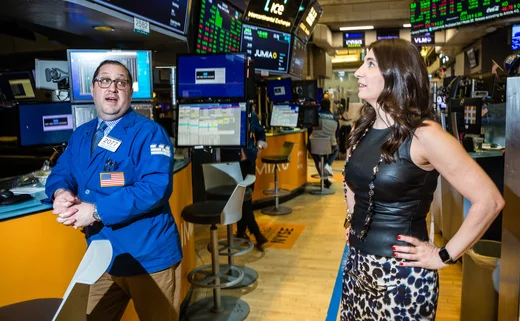
Only users who have a paid subscription or are part of a corporate subscription are able to print or copy content.
To access these options, along with all other subscription benefits, please contact info@waterstechnology.com or view our subscription options here: http://subscriptions.waterstechnology.com/subscribe
You are currently unable to print this content. Please contact info@waterstechnology.com to find out more.
You are currently unable to copy this content. Please contact info@waterstechnology.com to find out more.
Copyright Infopro Digital Limited. All rights reserved.
You may share this content using our article tools. Printing this content is for the sole use of the Authorised User (named subscriber), as outlined in our terms and conditions - https://www.infopro-insight.com/terms-conditions/insight-subscriptions/
If you would like to purchase additional rights please email info@waterstechnology.com
Copyright Infopro Digital Limited. All rights reserved.
You may share this content using our article tools. Copying this content is for the sole use of the Authorised User (named subscriber), as outlined in our terms and conditions - https://www.infopro-insight.com/terms-conditions/insight-subscriptions/
If you would like to purchase additional rights please email info@waterstechnology.com
More on Emerging Technologies
BMO’s cloud migration strategy eases AI adoption
The Canadian bank is embracing a more digital future as its cloud strategy makes gains and it looks to both traditional machine learning and generative AI for further augmentation.
Waters Wrap: GenAI and rising tides
As banks, asset managers, and vendors ratchet up generative AI experiments and rollouts, Anthony explains why collaboration between business and tech teams is crucial.
Ice moves to meet demand for greater cloud, AI capabilities
The exchange also outlined competitive advantages behind managing its data and cloud strategy internally during its Q1 earnings call on Thursday.
FactSet looks to build on portfolio commentary with AI
Its new solution will allow users to write attribution summaries more quickly and adds to its goal of further accelerating discoverability, automation, and innovation.
How Ally found the key to GenAI at the bottom of a teacup
Risk-and-tech chemistry—plus Microsoft’s flexibility—has seen the US lender leap from experiments to execution.
The IMD Wrap: Beginning of the end for data audits?
This week, there’s exciting news for data bean-counters in the form of a partnership between two vendors that could change the way we view and track data usage and audits.
S&P debuts Spark Assist genAI copilot, draws up ‘Blueprints’ of combined datasets
S&P’s Kensho subsidiary has rolled out new emerging tech products leveraging AI to explore and combine the vendor’s wealth of datasets to solve common use cases.
Most read
- Northern Trust building internal cloud data ‘marketplace’
- Chris Edmonds takes the reins at ICE Fixed Income and Data Services
- Northern Trust: Improving transparency across the asset servicing market




